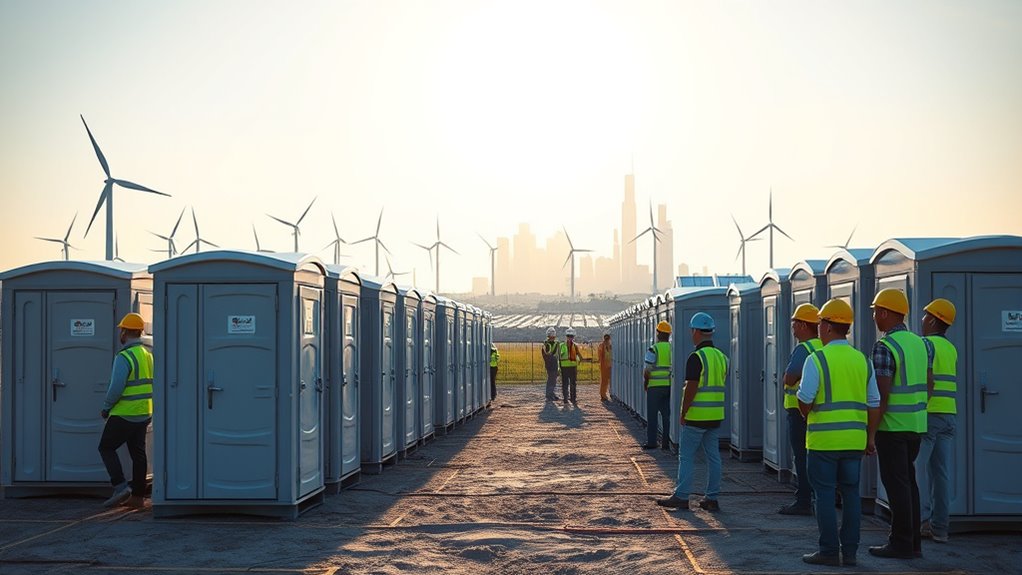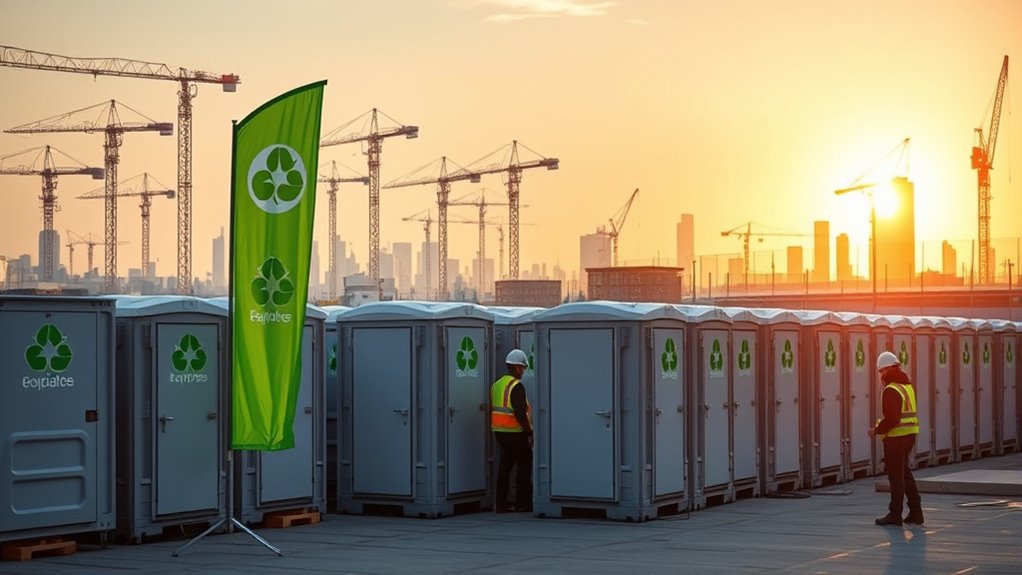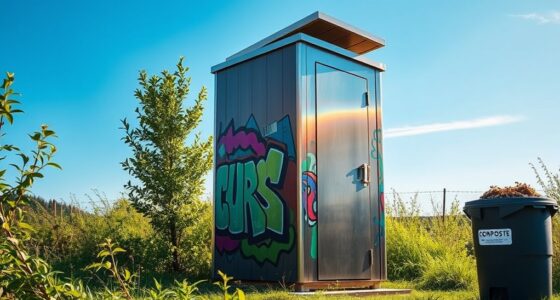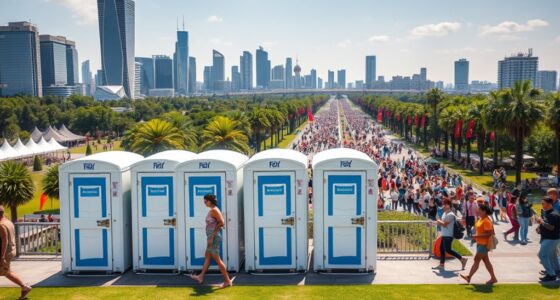Climate regulations are pushing the portable sanitation industry worldwide to adopt more sustainable practices. You’ll see companies upgrading to eco-friendly equipment, reducing water and chemical use, and adopting biodegradable materials. Stricter rules on waste disposal and emissions mean adapting operations quickly becomes essential. By embracing these changes, industry players can stay compliant and competitive. Stay tuned to understand how these evolving standards can help you lead in a greener, more responsible industry.
Key Takeaways
- Stricter regulations drive adoption of eco-friendly materials and sustainable technologies in portable sanitation units worldwide.
- Industry standards now emphasize reducing water usage, chemical emissions, and carbon footprint through innovative designs.
- Companies must continuously update equipment and train staff to comply with evolving environmental laws and market expectations.
- Regulatory compliance enhances brand reputation, attracting clients seeking environmentally responsible sanitation solutions.
- Proactive adaptation to climate policies positions industry players for growth, market leadership, and long-term resilience.

As climate regulations become more stringent, they are driving significant changes in the portable sanitation industry. You’ll notice that companies are now prioritizing environmental compliance to meet new standards aimed at reducing ecological footprints. This shift isn’t just about avoiding penalties; it’s about aligning your operations with global efforts to combat climate change. To stay competitive, you need to adapt your equipment, waste management practices, and materials to be more eco-friendly. Governments and regulatory bodies are implementing stricter rules on water usage, waste disposal, and emissions, compelling you to rethink traditional approaches. Your industry’s market adaptation involves integrating sustainable technologies, such as solar-powered units or biodegradable materials, ensuring your products meet both current regulations and future expectations.
Environmental compliance has become a core focus, shaping everything from design to service delivery. You’re now expected to reduce chemical use, lower carbon emissions, and improve waste treatment processes. This means investing in advanced sanitation units that minimize environmental impact while maintaining hygiene standards. For instance, many companies are upgrading to self-contained systems that reduce water consumption and facilitate easier waste disposal. Such innovations are not only regulatory responses but also strategic moves to appeal to environmentally conscious clients. You’ll find that clients increasingly prefer vendors who demonstrate a commitment to sustainability, which directly influences market positioning and growth opportunities. Staying informed about evolving regulatory standards is crucial for maintaining compliance and competitive advantage.
Reducing chemical use and emissions enhances sanitation and appeals to eco-conscious clients.
Market adaptation in this context requires agility. You must stay ahead of evolving regulations by continuously updating your equipment and operational protocols. This might involve retraining staff on new waste handling procedures or adopting new materials that are compliant with environmental standards. Additionally, you need to build flexibility into your supply chain to source eco-friendly components and materials that meet regulatory requirements. As more regions enforce stricter laws, your ability to swiftly adapt will determine your competitive edge. This proactive approach can open new markets, attract environmentally aware clients, and foster long-term loyalty.
In essence, the industry’s future hinges on how effectively you embrace environmental compliance and market adaptation. It’s no longer sufficient to simply meet existing standards; you must anticipate upcoming regulations and innovate accordingly. By integrating sustainable practices into your core operations, you not only ensure compliance but also position your business as a responsible leader in the portable sanitation industry. The ongoing evolution driven by climate regulations offers you the opportunity to lead change, differentiate your brand, and contribute positively to global sustainability efforts. Remaining adaptable and committed to environmental principles will be key to thriving in this new regulatory landscape.
Frequently Asked Questions
How Do Climate Regulations Impact Portable Sanitation Equipment Manufacturing Costs?
Climate regulations increase your manufacturing costs by affecting your supply chain and material costs. You might face higher expenses as stricter rules lead to sourcing more sustainable, often pricier, materials and supply chain disruptions. These changes force you to invest in eco-friendly equipment, which can raise production costs. Ultimately, you’ll need to balance compliance with cost management, ensuring your portable sanitation equipment remains affordable while meeting new environmental standards.
Are There Specific Regions More Affected by Climate Regulations in This Industry?
You’ll notice regional disparities in how climate regulations impact the portable sanitation industry, with some areas experiencing stricter policies and rigorous enforcement. Regions like Europe and parts of North America tend to have more extensive policies, increasing compliance costs. Conversely, areas with less enforcement see fewer immediate effects. These differences shape equipment standards, innovation, and operational costs, making it essential for industry players to understand local policy enforcement to adapt effectively.
How Is the Industry Addressing Compliance Challenges With New Regulations?
You’re likely facing regulatory hurdles as new climate regulations come into effect. To address this, the industry adopts compliance strategies like upgrading equipment for better efficiency and reducing emissions. You may also implement staff training to guarantee adherence and stay informed about evolving standards. Proactively embracing innovative solutions helps you navigate these challenges, ensuring your operations remain compliant while contributing to environmental sustainability.
What Innovations Are Emerging Due to Climate-Related Restrictions?
You’re seeing innovations like eco-friendly materials and renewable energy powering portable sanitation units. These advancements help you meet climate restrictions while reducing your environmental footprint. By adopting biodegradable components and solar-powered systems, you can operate more sustainably and stay ahead of regulations. These innovations not only improve compliance but also appeal to eco-conscious clients, giving your business a competitive edge in a rapidly evolving industry.
How Do These Regulations Influence Global Portable Sanitation Market Trends?
You’ll notice that climate regulations drive the portable sanitation market toward sustainable materials and stricter regulatory compliance. These policies push you to adopt eco-friendly products, reduce waste, and meet new standards. As a result, market trends shift toward innovative, environmentally conscious solutions. You’ll find growth opportunities in developing sustainable equipment and services that align with global efforts to minimize environmental impact, ensuring your business stays compliant and competitive in this evolving landscape.
Conclusion
As climate regulations tighten, you might picture the once-quiet portable toilets transforming into eco-friendly marvels—sleek, sustainable, and green. While the industry faces challenges, it’s also embracing innovation, turning waste into resources and reducing its footprint. This shift is like a gust of fresh air in a smoggy world, showing that even in the messiest corners, change is possible. Together, you’re helping build a cleaner, more resilient future—one portable unit at a time.









